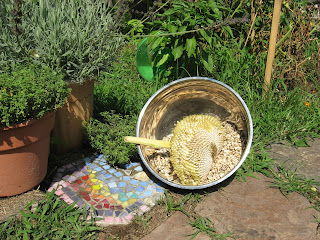My husband and daughter live for a treat after dinner. They are both drawn to dairy-base desserts, whether they are baked or frozen; they will relish in contentment. A nice way for all of us to cool down and treat ourselves during the evenings as we sit in our snug home is to make cold treats. Here are two of our favorites.
One of our favorites is pudding. And I got to thinking about how relevant pudding is at this time of the year. Historically, pudding has a different personality than our current “American” sweet pudding. In fact pudding dates back to ancient times. It was actually a meat-based meal of necessity, differentiated between black and white. In the 1600’s, it is believed that pudding expanded their scope to included either a savory (meat-based pudding) or now a sweet pudding (flour and sugar-based). We were later to discover through word history that pudding actually was the sausage. The word pudding back in the 1400’s meant a human meal made of animal the stomach, intestine lining filled with meat of that animal, herbs, oatmeal, and then boiled.
The pudding I’ll suggest today is more of a custard. Custard is an oldie and dates back to the Middle Ages. Those smart Romans were familiar with the property of binding eggs. Again historically, custards were meat-based and savory, but within a few hundred years Europeans and American began to create sweet custards we now today as pudding.
Etymology of pudding:
c.1300, "a kind of sausage: the stomach or one of the entrails of a pig, sheep, etc., stuffed with minced meat, suet, seasoning, boiled and kept till needed," perhaps from a West Germanic stem *pud- "to swell" (cf. O.E. puduc "a wen," Westphalian dialect puddek"lump, pudding," Low German pudde-wurst "black pudding," English dialectal pod "belly," also cf. pudgy).
http://www.etymonline.com/index.php?search=pudding (Dec. 7, 2012)
We are making homemade pudding pops today. I have this awesome kitchen gadget that helps me freeze my pops just right. IT’s the ZOKU. Santa brought it last year. http://www.zokuhome.com/ (might be just the right, last minute gift for someone in your home!) I’ll start with the homemade pudding recipe. It’s delicious.
Homemade Pudding Pops
Serves
6
3 ½ cups of milk, fattier the better
½ cup cocoa (add if you want chocolate flavored)
1/3 cup and later ¼ cup sugar
¼ cup cornstarch
1/8 teaspoon of salt
2 large eggs
1 egg yolk
2 teaspoons of vanilla extract
1 Tablespoon butter
Serves
6
3 ½ cups of milk, fattier the better
½ cup cocoa (add if you want chocolate flavored)
1/3 cup and later ¼ cup sugar
¼ cup cornstarch
1/8 teaspoon of salt
2 large eggs
1 egg yolk
2 teaspoons of vanilla extract
1 Tablespoon butter
Directions:
In bowl, whisk 1/3 cup sugar, cocoa, cornstarch, salt, eggs, and yolk. Whisk in a ½ cup milk. Set aside.
Heat rest of the milk and sugar. Bring to boil.
Remove from heat. Gradually pour hot mixture into egg mixture whisking constantly, until mixture is smooth.
Transfer combined mixture to heavy bottomed pot and heat over medium-low, stirring constantly, until the mixture thickens to a mixture (like mayonnaise) 3-5 minutes.
Remove from heat and whisk in butter and vanilla extract.
At this point if you are making straight pudding, pour into 6 serving dishes, cover with plastic wrap, and refrigerate about 2 hours..
If you are interested in pudding pops, let cool 5 minutes, then pour into your freezing tool (ice cube trays). I use the ZOKU. It sits for about 10 minutes and wah-la – puddin’ pops.






















